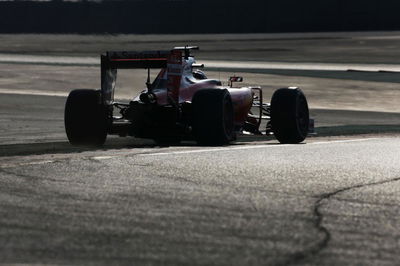Max Yamabiko: Haas VF-16 - A closer technical look

Though few may expect much from the Haas VF-16 this season based on the form of previous all-new entries, a closer look at the tidy car suggests it could well prove something of a surprise package.
Firstly, the car is certainly conventional without many major remarkable details of note. The only thing which really jumps out at me is an odd bump on the nose just where the torsion bars, bell crank and damper tops sit. As Haas has all of its suspension components direct from Ferrari, perhaps the Italian team changed the design of its components after Dallara had finalised the monocoque; either way it looks rather clumsy on an otherwise very neat car.
Indeed, so much of the Haas has come directly from Maranello it is probably a surprise that the car is not more like the Ferrari SF16-H. The two cars share uprights, suspension, gearbox, power unit, electronics, hydraulics, and control systems, and I have heard that they also share the same fuel tank design: this defines much of the rear of the chassis along with the battery pack (again direct from Ferrari).
By regulation, the aerodynamic surfaces must be bespoke to the team, but Haas - jointly with Ferrari - took advantage of a loophole in 2015 to allow them to increase the amount of aero data for both sides. The aerodynamic testing restrictions in F1 limited Ferrari on wind tunnel time in 2015, but the rules did not apply to Haas as in 2015 they were not an F1 entrant. Taking advantage of this, Ferrari and Haas shared aerodynamic data and the two teams both used the same (Ferrari) wind tunnel. There were even rumours that at times the two even used the same 60% scale wind tunnel model.
What is certain is that a number of engineers - including Ben Agathangelou - worked across both projects and that knowledge from both was transferred. The details of how integrated the two projects were is unclear, but it annoyed other teams - such as Mercedes - to the point where a stewards' decision had to be made in Abu Dhabi about the situation. The conclusion was that neither Ferrari or Haas had done anything wrong, but the data sharing could not continue and engineers working on the aero designs would have to work on one or other project but not both.
Whatever the reality, exploiting this loophole in essence allowed Ferrari to get more wind tunnel time than its rivals, while Haas got a solid basis on which to develop the VF-16 with more resource than they would have otherwise had. As a result, I rather expected the Haas to be very similar in terms of aero to the Ferrari and as such it was no shock to see that the Haas uses near-identical front wing, rear wing, brake ducts and more.
There are some notable differences, and these centre around the parts of the car which Dallara built. The nose is quite different to that of the Ferrari, as are the upper impact structure and the air box. The sidepods too appear a bit larger on the Haas, probably because the coolers were developed jointly by Dallara and Haas, not Ferrari - which has a different type of radiator core.
I do get the impression that the team has not fully gelled yet. It is made up of a mix of full-time Ferrari staff, former Manor staff and a number of Ferrari staff on secondment from the Italian company. There are a few staff from Haas in North Carolina, but these tend to be on the design side, especially in terms of fabrication and CFD. This lack of gelling is perhaps to be expected, and has resulted in the VF-16 getting a bit less running than expected with a few small issues in both private testing and in the official sessions.
A front wing failure at 320kph was caused by a manufacturing issue with one of the Dallara-built parts and saw the Ferrari-made wing part company with the new car. But with a new project failures like this are not uncommon: let's not forget that the Mercedes W05 lost its front wing in similar fashion at Jerez at the start of the 2014 season.
It will be very interesting to see how the VF-16 develops through the season and if it follows any of the technical directions of the Ferrari now the two aerodynamic programmes have been separated. In conclusion, although the Haas car is a very good piece of work considering it is from such a new team, it was never going to be a bad car thanks to the unusual way it was developed. It remains to be seen if other teams follow this almost customer car direction set by the newcomers.











